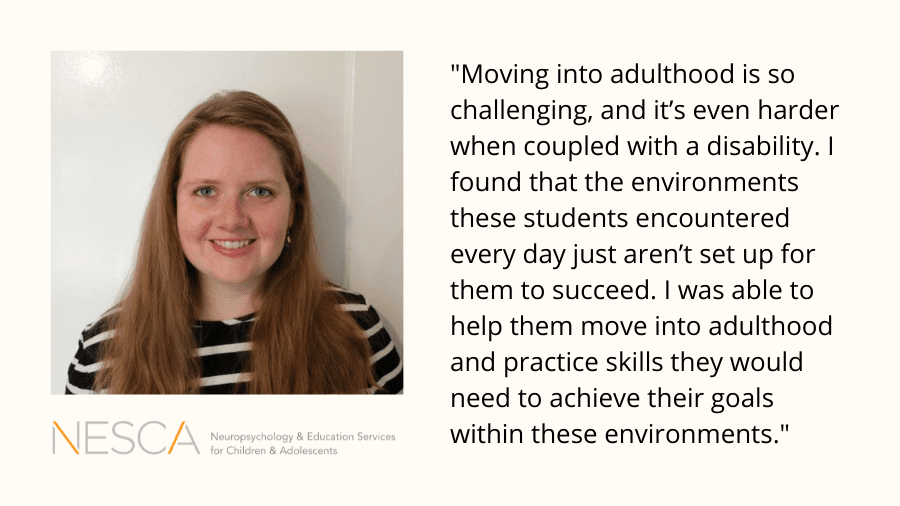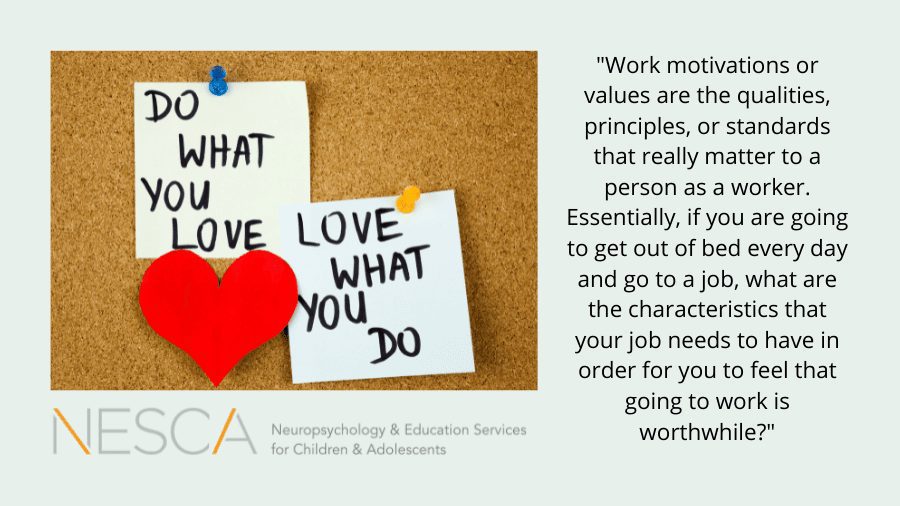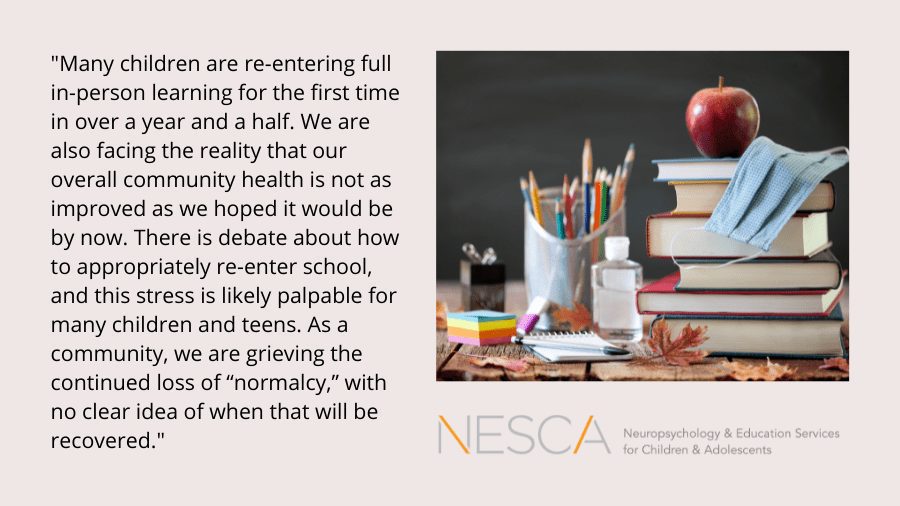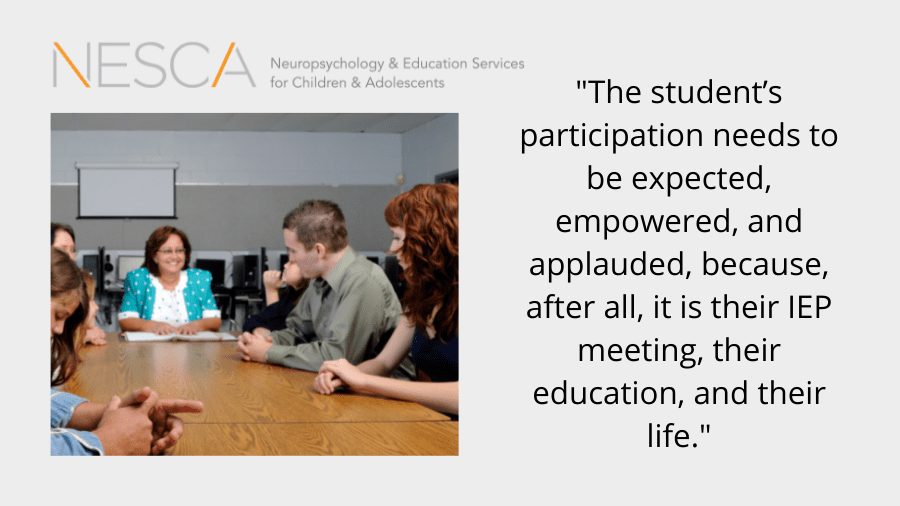
 By: Sophie Bellenis, OTD, OTR/L
By: Sophie Bellenis, OTD, OTR/L
Occupational Therapist; Real-life Skills Program Manager and Coach, NESCA
Personal, professional, and academic goals are a large part of what drives us as we transition from one stage of life to the next. They also provide direction as we choose and maintain the habits and routines that we feel are important to daily life. Determining what our goals are is a big step, one that students are often working on with their families, school supports, and friends as they start to figure out their next steps in life. But once these goals are solidified, what’s next? How do we get there? As an executive function coach working with high school and college students, I can attest that this can unexpectedly be the most difficult step in the process. Let’s talk about some ways that we can support students in these endeavors.
- Break down goals into manageable chunks. Many goals tend to be large or long-term and can feel daunting and amorphous. For example, a common goal for high school seniors might be, “I will apply to five colleges by their application deadlines.” We can help students by breaking a goal like this down and creating step by step lists, such as: put together a list of preferences for my ideal school, research schools that fit these preferences, meet with guidance counselor to review my research, finalize list of five schools, ask teachers for letters of recommendations, fill out each section of the Common App, write personal essay, have English teacher or other support person review personal essay and give feedback, etc. This list is not comprehensive, but it does show how much goes into the seemingly simple initial goal.
- Help them prioritize. Once students have created a comprehensive list of steps, help them to understand what steps need to be attended to right away and which can wait. Continuing with the example of applying to college, figure out what steps need to happen before the Thanksgiving or winter break! It may also be helpful to figure out which steps seem difficult for your specific student. For some, this may be writing the personal essay; for others, it may be building up the courage to ask a favorite teacher to write them a recommendation. Busy students who are already taking multiple classes may have trouble figuring out how to add the steps needed to reach another goal into their schedule.
- Put together a plan. Set a timeline. Put internal deadlines into a calendar. Figure out specific times to work towards the goal. Find people who can be solid supports and help to make things happen.
- Check in on them. Offer to check in along the way. Some students will love having a partner to track their progress with, while others simply need help setting the foundation.
While this example is very concrete and includes working towards a specific predetermined deadline, not all goals need to be. Whether your student’s goal is to find a summer job they enjoy, get an average of a B in all of their classes, or find a new hobby that makes them happy, using these strategies can help to make a goal feel more manageable.
Finally, you might notice that these steps are quite similar to some of the strategies for completing specific academic tasks, and you would be right! Take, for example, writing a research paper. We want students to break that task down into smaller pieces, such as finding sources, creating an outline, writing a rough draft, and developing a final draft. We then help them to prioritize which steps will need more time to complete and eventually put together a plan so they dedicate sufficient time to each section and submit a final draft on time. Many of the academic executive function tasks that we learn in school create processes and roadmaps for how to tackle life skills that require similar executive function skills. However, not all students can transfer these skills to setting goals without some direct support or help seeing the similarities in the process.
To learn more about Executive Function from Dr. Bellenis, join her along with Dan Levine from Engaging Minds, for a free webinar, “Executive Function in the Covid Era: Managing School and Life (Kindergarten through High School),” on March 8 at 7:00PM ET.
Register now: https://engagingmindsonline.zoom.us/webinar/register/WN_vWNlilZkS36imBqvr4IMZQ

About the Author
Sophie Bellenis is a Licensed Occupational Therapist in Massachusetts, specializing in educational OT and functional life skills development. Bellenis joined NESCA in the fall of 2017 to offer community-based skills coaching services as a part of the Real-life Skills Program within NESCA’s Transition Services team. Bellenis graduated from the MGH Institute of Health Professions with a Doctorate in Occupational Therapy, with a focus on pediatrics and international program evaluation. She is a member of the American Occupational Therapy Association, as well as the World Federation of Occupational Therapists. Having spent years delivering direct services at the elementary, middle school and high school levels, Bellenis has extensive background with school-based occupational therapy services. She believes that individual sensory needs and visual skills must be taken into account to create comprehensive educational programming.
Neuropsychology & Education Services for Children & Adolescents (NESCA) is a pediatric neuropsychology practice and integrative treatment center with offices in Newton, Massachusetts, Plainville, Massachusetts, and Londonderry, New Hampshire, serving clients from preschool through young adulthood and their families. For more information, please email info@nesca-newton.com or call 617-658-9800.



 meaningful skills in order to reach their goals. She has spent the majority of her career working in a private school for students with ASD. She has also spent some time working in an inpatient mental health setting. Lyndsay uses occupation-based interventions and strategies to develop life skills, executive functioning, and emotional regulation. While completely her doctoral degree at MGH Institute of Health Professions, Lyndsay worked with the Boston Center for Independent Living to evaluate transition age services. She uses the results from her research to deliver services in a way that is most beneficial for clients. Specifically, she focuses on hands-on, occupation-based learning that is tailored the client’s goals and interests.
meaningful skills in order to reach their goals. She has spent the majority of her career working in a private school for students with ASD. She has also spent some time working in an inpatient mental health setting. Lyndsay uses occupation-based interventions and strategies to develop life skills, executive functioning, and emotional regulation. While completely her doctoral degree at MGH Institute of Health Professions, Lyndsay worked with the Boston Center for Independent Living to evaluate transition age services. She uses the results from her research to deliver services in a way that is most beneficial for clients. Specifically, she focuses on hands-on, occupation-based learning that is tailored the client’s goals and interests.





 Londonderry, NH office. She specializes in the evaluation of anxious children and teens, working to tease apart the various factors lending to their stress, such as underlying learning, attentional, or emotional challenges. She particularly enjoys working with the seemingly “unmotivated” child, as well as children who have “flown under the radar” for years due to their desire to succeed.
Londonderry, NH office. She specializes in the evaluation of anxious children and teens, working to tease apart the various factors lending to their stress, such as underlying learning, attentional, or emotional challenges. She particularly enjoys working with the seemingly “unmotivated” child, as well as children who have “flown under the radar” for years due to their desire to succeed.



Connect with Us